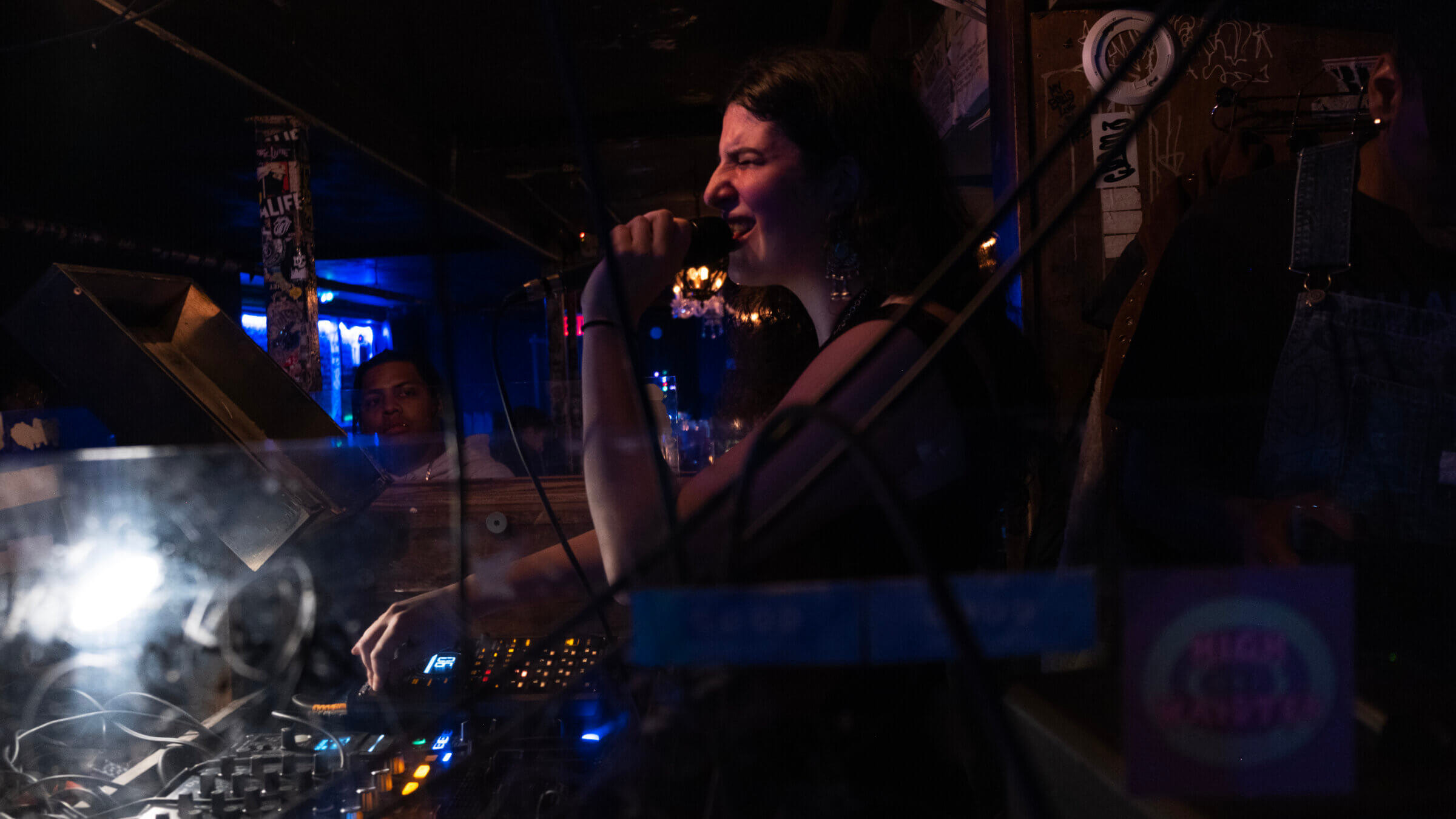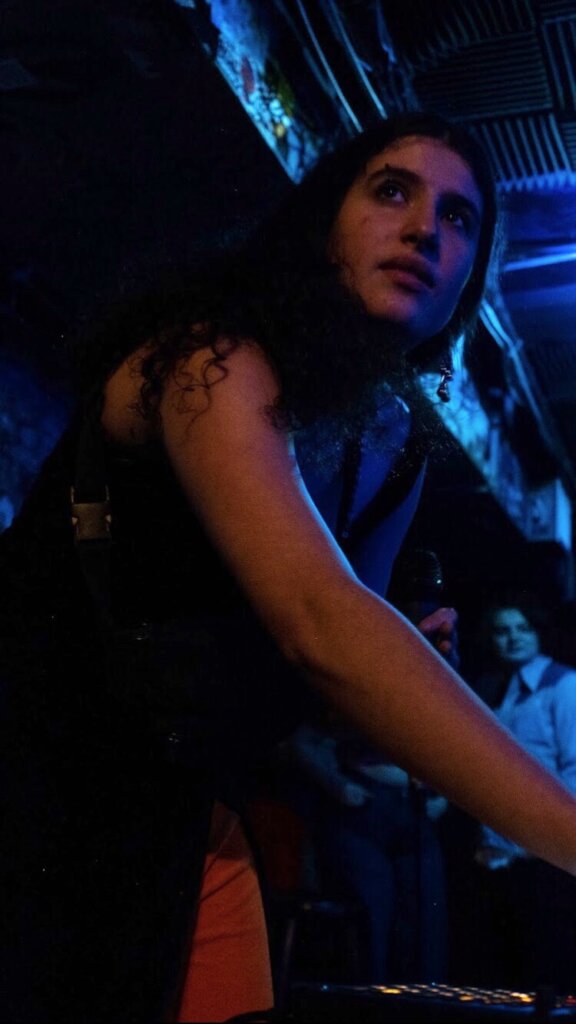Klezmer Techno Music? This 22 Yearold Is Making It A Thing

Kaia Berman-Peters is on sabbatical from the Harvard/New England Conservatory of Music program. He plans to record his first Kleztronica album this summer. Courtesy of Berman Peters
They call it Klajtronica. Primarily electronic dance music with elements of klezmer, the genre is mostly sampled and synthesized, although old-school unplugged instrumentation is used live. Kaya Berman-Peters, a 22-year-old student from New York, credits Closetronica with her invention as "the first of its kind."
Josh Dolgin, the godfather of klezmer hip-hop, replies, "Everybody under a certain age thinks they've got it all figured out."
Montreal musician Dolgin is widely recognized as a pioneer of incorporating samples into klezmer music. Berman met Peters during a recent visit to New York and was convinced that the Clijtronica "scene" was here to stay.
The Jewish EDM scene

To date, Berman Peters has hosted three events for Klejtronica, starting with an after party at Yiddish New York in December. Two marches took place in March: one brought 500 people to Boston's Purim festival; Another was held at Trans-Picos, an EDM venue in Queens. A second night at Trans Pecos is scheduled for this week in collaboration with Clear the Floor, the Boston-based BIPOC collective, which hosts four of the night's nine events.
The other five events were selected by Berman Peters. Three of them used actor pronouns: Sam Slate, who played Diva Nigun and formerly sang in a Yiddish choir; Abby Goldberg as Chava Goodtime in drag; and Beyla Ungar, a former dancer who describes herself online as "a weird, weird white Ashkenazi Jew." Young Unger's father, Howard Unger, is a klezmer trumpeter from Washington, DC. Berman-Peters called the Klejtronica scene "a very strange place". He also uses the stage name Chaiya.
At 20, Klejtronica's fifth act is Brooklyn-based multi-instrumentalist Eleanor Weil, who plays a millennial instrument called the Dolly. Although strings are played by turning a hand crank on the medieval instrument, the effect is produced by an effects processor controlled by pedal guitarists, giving the wheel the ability to add reverb, vibrato, tremolo and wah-wah. Will apparently refers to it as space gore because it looks like "20 aliens together".
"It's very hard and powerful," he said. "It's like a drawstring bag. Most people can't handle it."
"Very strange place."
So is Closetronica, which borrows disco beats from the house music pioneered by African-American producers in Chicago in the 1980s. House is known for its so-called four-note rhythm , where the bass is played on each beat. Kleztronica rhythms and synth harmonies may appeal to some instrumental klezmer fans.
But Kleztronica performances have a human touch. Berman-Peters is known for singing along to music played by samples and has a beautiful voice.
"Making a home in the diaspora is a big thing for me, and Clijtronica is my version of that," says Berman-Peters.
Berman Peters is on sabbatical from the Harvard/New England Conservatory of Music program. He plans to record his first Kleztronica album this summer. But he doesn't just play EDM klezmer; He sings with the Boston klezmer group Mama Liga and is a member of the Boston klezmer trio Levios.
"He's an amazing musician," said veteran singer and klezmer musician Jeff Warschauer, who met Berman Peters when he was 14 and joined the Columbia University klezmer group he leads.
How shadows make music
Berman Peters' flagship "instrument" is the Roland SP 404 MKII, a $500 sample with a hardcover book of approx. Although he has been working for more than a year, he excels at playing the accordion, a 17-pad instrument used for samples and rhythms.
In addition to musical instruments prepared by sampling, voices and voice samples are used. In one article, he starts with a few lines of poetry and then makes them sound like editorial comments rather than creative development. Some conversations are incomprehensible and not just because they are in a language other than English.
Spill , Klezmer, Spill! The 12-minute-long clip on the SoundCloud page uses samples of Holocaust survivors reading Spill Purim, which went 'door to door' in Eastern Europe. New England Music in May 2022.
Her eight-minute single " Leave It Out " also features recordings from artists and activists such as Emma Goldman, Jenny Romizon, Molly Bacon, and Michal Yashinsky on issues such as gay politics and the treatment of Palestinians. (Berman-Peters says she is committed to addressing "the damage of Zionism" in her essays and live performances.)
Pianist Anthony Coleman, who worked with Berman-Peters as a conservatory teacher, said he admired " Leave It " and compared it to Public Enemy's work because it "resonates with what it is." Berman Peters' kleztronica songs are also reminiscent of radio mixes heard on left-wing stations like WBAI, where current affairs and pop music combine to comment on current politics.
Coleman has a long history of exploring Jewish music with the Sephardic bands Tins and Ras Hatters. It was Coleman who produced the sample for his friend David Krakow's 1995 Klezmer Madness ! Frustrated with attempts to use abstract words associated with Judaism, Ma eventually abandoned the sampling technique. In 2010 Coleman noted that the 2023 sample technology is light years ahead of the sample time.
A new era for Jewish house music
"The level of technology we worked with in the '90s is nothing compared to what you have now," Coleman said. "There's no comparison. We had to work with limited memory. And now you have all this stuff at your fingertips. Now that it's so easy, what do you do with it?"
While teaching a course on "Issues and Trends in American Music" at the conservatory, Coleman spent some time listening to several successful EDM artists, including the American duo Diplo and Skrillex. Coleman says the music on Diplo's recordings "sounds the same to me."
But Hankus Netsky, chair of the New England Conservatory of Contemporary Music and a consultant to Berman Peters, believes that despite electronic music's flaws, Klejtronica is finding a way to connect with young people. to their ethnic roots. This is something that the mainstream Jewish community has turned a blind eye to, says Nietzsche.
Steeped in Jewish mysticism
"Kaya is the perfect person to do what she does," Nitsky said. "He comes from a very strong Jewish background. He's very steeped in a level of Jewish mysticism that you don't know much about."
Another teacher, Basia Schechter Berman, has known Peters since childhood. Singer Shechter, best known as the founder and lead singer of the world-class music group Pharaoh's Daughter, remembers Kaya sitting on her father's lap and receiving Jewish mysticism from the family.
"He's creating a new klezmer movement and bringing it into the 21st century, " Schechter said . "It's not just a genre, it's a way to bring a certain generation of people together. They build a scene around it."
Members of Berman Peters in their 20s and 30s are certainly not the first Klozmore to use sampling . That was at least 30 years ago.
Klezmatics trumpeter Frank London sampled the klezmer score for the 1993 documentary The Shvitz . The following year, the samples were part of the mixtape for the album by the Jewish group The Hooters . London is working on a new album on the Borscht Beat label, made from recordings he's had on his hard drive for over 10 years. According to label CEO Aaron Bendich, it promises to expand the boundaries of Jewish EDM. Heart guitarist Sam Day, responsible for Eleanor Weill's Space Line, has a hand in mixing the upcoming album.
Krakauer game with Klezmer madness samples! The recording was the first CD released under the radical Jewish cultural imprint Tzadik Records. Additional samples were released on Krakauer's Next Recordings, Klezmer, NY 1998 .
If you want to hear a sample that mixes old and new in an interesting style, listen to Wally Brill's 1997 album Testament . Mix samples of soul songs from the 20s, 30s and 40s with synth-heavy dance groups.
Although they didn't hit the scene until the mid-2000s, they were influential in bringing Balkan beatbox sampling and hip hop into the realm of klezmer.
But no one working regularly in the klezmer scene has used sampling as effectively as Dolgin, who found his way into klezmer music from hip-hop.
In 1999 or 2000, Dolgin reluctantly visited Canada for the first time. He didn't find the vanity scene he'd hoped for and used a few recorders, including Krakauer, the late Pete Sokolow, and Philadelphia drummer Eileen Hoffman Watts.
"It was really important for me to start doing what I do because his rhythm is so fun and unique, but also completely repeatable and testable," Dolgin says of the late drummer.
In the more than 20 years since then, Dolgin has recorded several albums, played in major klezmer bands, and composed music. His stature as a performer and shaker in the klezmer scene was such that McGill University hired him to teach a Jewish music class.
"What surprised me was that after I did (using the klezmer sample), it didn't show up anymore," Dolgin said. No one has learned, really, yet. So the new generation now has the tools and knowledge of old and new dance music to create this kleztronica scene, really getting some 'scene'.
The next Kleztronica will be held on July 20 in Trans Pecos.


